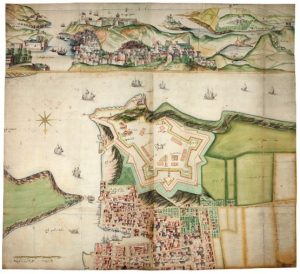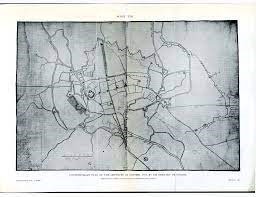Blog by Makenzie Snarey
As we continue with archival research and report writing for our excavations, we came across the question; Who designed the Royal Fort? Bernard de Gomme would be the person in question! His name may not be as famous as Charles I or Oliver Cromwell but his countless fortifications across England changed military engineering. Little is known about de Gomme before his military apprenticeship as an engineer with Fredrick Henry, Prince of Orange in 1641[1]. However we do know he was born in 1620 in the Netherlands and died in 1685. At 22 years old, de Gomme was appointed quartermaster-general before he accompanied Prince Rupert to the storming of Bristol in 1643 and was later knighted by Charles I in 1645 [2] . Under Prince Rupert, de Gomme constructed the Oxford fortifications as well as Liverpool, Newark, and of course, Royal Fort.[3] He followed Prince Rupert into exile in 1646 but returned to serve as Charles II’s Chief Engineer in 1661. During his second stay in England, de Gomme constructed countless fortifications including Dunkirk, Plymouth (pictured to the right), and Tilbury, and reconstructed the Tower of London and Windsor Castle.[4] Much of these plans are now kept in the British Library and readily available for viewing!

De Gomme’s battle maps and engineering plans are extensively detailed. Edmund Turnor’s 1803 landscape of Bristol was the assumed structural layout of the Civil War, but De Gomme’s map provided several fortifications that Turnor left out.[5] Not only were de Gomme’s maps and plans thorough, but so was his account of the 1643 siege. The link below is a transcription of the account by Lieut.-Colonel G.H. Leslie. While De Gomme’s account of the siege is meticulous in some regards, he is criticized for not providing further detail on the royalist line after it moved from Stoke’s Croft to Tower Harratz. [6] While in Bristol, De Gomme oversaw the fortification and improvement of abandoned parliamentarian defenses such as Windmill Fort which became Prince Rupert’s headquarters. [7] This included the Royal Fort which was described to be a “practical solution for the elevated terrain.” [8] Bernard De Gomme’s Royal Fort’s blueprints may be lost but excavation efforts have and continue to uncover Bristol’s strongest Civil War defense.

Lieut.-Colonel G.H. Leslie transcription: https://www.jstor.org/stable/pdf/44227516.pdf?refreqid=excelsior%3Afc6288a786d9ad8f1f87ff8080af569f
[1] Christopher Storrs, Review of Fortress Builder. Bernard de Gomme, Charles II’s Military Engineer, by Andrew Saunders, (Exeter: University of Exeter Press, 2004): 119.
[2] “Sir Bernard de Gomme,” Fortified Places, accessed 2021.
[3] “Sir Bernard de Gomme”.
[4] Storrs, 119.
[5] Patrick McGrath, Bristol and the Civil War (Bristol: Alan Sutton Publishing Limited, 1981), 49.
[6] McGrath, 49.
[7] Andrew King, “‘Not fullye so loftye’: excavations at the Royal Fort, St Michael’s Hill, Bristol,” Post-Medieval Archaeology 48, no. 1 (2014): 4.
[8] King, 38.

